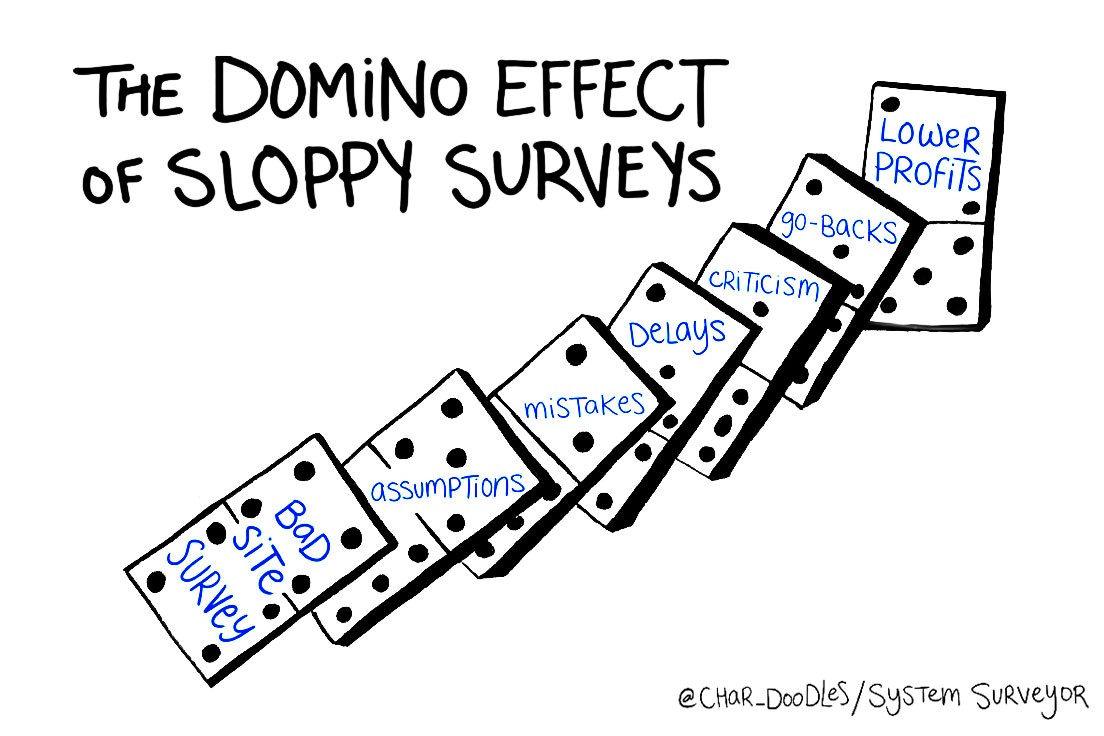Having an efficient and effective means of creating a site survey can be the difference between a well-executed project and a bad experience for everyone involved. As SDM Magazine put it, “Networks have transformed over the years from disparate, hardwired systems to integrated multi-layered systems with a combination of hardwired and wireless access points, and an amalgamation of devices all going back to the same place.” Communicating with customers about what they want has become more complex and detailed.
Therefore, ensuring that a site survey has been thoroughly conducted with all possible details is of the utmost importance. A poorly run site survey can create a domino effect of problems for a system integrator and their customer. So how can an integrator avoid these problems? With the complexity of the systems involved and the wide variety of customer desires, how can a site survey be done today while avoiding this negative domino effect?
A typical security system is in service for 7-10 years. If done incorrectly, the company will have to deal with a deficient system or have to pay additional costs to fix it. A bad site survey has a negative domino effect not only on the overall lifecycle system, but also on the company’s relationship with their customers. If you start out poorly, then the project will end poorly.
The System Lifecycle & Site Survey’s Role
The system lifecycle consists of planning, analysis, design, installation, and maintenance. The site survey embodies every single one of these stages. The site walk and the notes taken initiate the planning process. Once finished, analysis of the site survey begins. Design is then handed off to the engineers who will send the technician to the customer to review the survey before installation. If correct, installation begins, and the system goes live. Routine maintenance relies on the original site survey for notes and process updates.
If any part of the site survey process is disrupted or is inaccurate, it can compromise the efficiency of the system lifecycle. That can cost both the integrator and the customer a great deal in the long run.
The Costs of a Bad Site Survey
When a site survey is done poorly, it takes a toll on a company’s professional reputation. It shows customers that the company is not equipped with the right tools, leaving them with a sense of uncertainty about the services they’ve received. This leaves the customer questioning whether or not their requirements and desires are being met.
When the information from a poorly conducted site survey reaches an engineer, they’re often left with questions and the need to make assumptions in order to make delivery of a project. This leads to high levels of risk for a project. Frequently the engineers will feel the need to add costs in order to offset the risk. Sometimes they will even price it under what it should be because they do not have full information. This takes away the company’s competitive advantage, and will ultimately decrease their profit margins.
By the time a bad site survey reaches the installation team, it’s not the same as what the sales person proposed to the customer. The project can halt there until things get straightened out. This can delay a project for days if not weeks, hurting cash flow, increasing costs with go-backs, and decreasing profit margins. So how can this all be avoided? What methods and tools can an integrator utilize to be more effective?
Tools and Methods to Conduct a Successful & Effective Site Survey
“Time is everything for both an integrator and the customer” – Eman Taylor, Customer Support Specialist – System Surveyor
Taylor encourages integrators to begin and end the site survey process correctly and efficiently. Proper presentation to the customer helps to avoid mistakes and miscommunications. Mistakes are not only time consuming but also costly.
Chris Hugman, who served as a system integrator for many years shared that integrators should use tools to engage customers for a better site survey. “Getting floor plans before the site walk can really help you better engage with the prospect,” says Hugman. He also recommends taking pictures during the survey and annotating notes on each photo. Hugman believes that, “communicating clearly with the customer throughout the process about their desires and the progress of the project is a great way to prevent errors and inaccuracies.”
So what tools are out there for integrators that can make their job easier and reduce mistakes and miscommunication? That’s where System Surveyor comes in.
System Surveyor Creates a Positive Domino Effect
The moral of this story is that a bad site survey is unprofessional and will hurt your company and customer relationships in countless ways. If a customer has a bad experience with a company, it could severely damage the company’s reputation, and in business, reputation is everything. People are more willing and more likely to tell others about a bad experience than a good one. As Hugman says: “Trying to install a security system without a good site survey is like trying to build a house without a good architect and his/her plans.”
Strive to get things right from the beginning with an efficient and effective site survey in order to improve reputations, lower costs, and increase profit margins. System Surveyor allows system integrators to design, plan, and maintain their systems. Users of System Surveyor’s mobile app can upload a floor plan and plot where their IoT hardware is to be placed making it easier to understand customer needs and to install new project. Embrace change in the system integration industry and try a free trial here today.
{{cta(‘d227f059-fd07-4872-bbc2-396f7e2931f7′,’justifycenter’)}}
